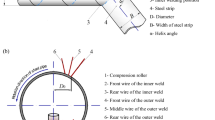Abstract
This paper presented residual stress measurement on two circumferential Variable polarity plasma arc welding (VPPAW) joints and one circular closed Friction stir welding (FSW) joint on the propellant tank of 2219 aluminum alloy using the indentation strain-gauge method. Quite large tensile residual stresses were attached to the center and inner areas of the circular closed FSW joint. There were very large tensile stresses in some points of the two circumferential VPPAW joints, among these points, the maximum value was +253 MPa, which was about 63 % of the yield strength of 410 MPa measured in the base material. In addition, the peak of compressive residual stress was about -160 MPa. Above all, there were two typical peaks of residual stress in the circumferential VPPAW joints, one was located in the middle part while the other one was near the start/end position of the joints. Combining the result of residual stress measurement with the characteristics of the tank structure, it can be concluded that circular closed FSW joint around the flange was a weak spot on the propellant tank. And the most vulnerable point on the circular closed FSW joint has also been found.
Similar content being viewed by others
References
Y. H. Zhang, S. Smith, L. W. Wei, C. Johnston and A. Stacey, Measurement and modelling of residual stresses in offshore circumferential welds, 32nd ASME International Conference on Ocean, Cambridge, United Kingdom(2013).
G. Pouget and A. P. Reynolds, Residual stress and microstructure effects on fatigue crack growth in AA2050 friction stir welds, Int. J. Fatigue, 30 (3) (2008) 463–472.
S. G. Xu and Y. L. Zhao, Using FEM to determine the thermo-mechanical stress in tube to tube-sheet joint for the SCC failure analysis, Eng. Fail. Anal, 34 (2013) 24–34.
S. Wataru, A. Takayuki, I. Takashi, E. Kunio, H. Eisaku and I. Tetsuya, Stress corrosion cracking countermeasure observed on Ni-based alloy welds of BWR core support structure, Nucl. Eng. Des, 239 (4) (2009) 655–664.
J. H. Shi and S. Booth, An investigation of effects of welding residual stresses on creep crack growth for a low alloy butt weld, Int. J. Pres. Ves. Pip, 108–109 (2013) 67–71.
W. F. Xu, J. H. Liu and H. Q. Zhu, Analysis of residual stresses in thick aluminum friction stir welded butt joints, Mater. Des., 32 (4) (2010) 2000–2005.
P. V. Venkitakrishnana, P. P. Sinhaa and R. Krishnamurthy, Study and analysis of residual stresses due to various secondary processes in AA 2219 annealed sheet using acoustic emission and hole drilling methods, NDT&E International, 38 (8) (2005) 615–622.
H. Y. Fang, J. H. Dong, W. X. Wang and X. S. Liu, Welding structure, First Ed., China Machine Press, Beijing, China(2008).
S. Fricke, E. Keim and J. Schmidt, Numerical weld modeling-A method for calculating weld induced residual stresses, Nucl. Eng. Des., 206 (2–3) (2001) 139–150.
C. H. Lee and K. H. Chang, Effect of the welding sequence in the circumferential direction on residual stress distribution in a thin-walled pipe weld, J. Eng. Technol., 223 (6) (2009) 723–735.
H. Purmohamad, A. Kermanpur and M. Shamanian, Numerical simulation and experimental investigation of residual stresses in the circumferential butt GTAW of incoloy 800H pipes, J. Mater. Eng. Perform., 19 (1) (2010) 13–21.
E. F. Rybicki, P. A. McGuire, E. Merrick and J. Wert, Effect of pipe thickness on residual stresses due to girth welds, J. Press. Vess. T. ASME, 104 (3) (1982) 204–209.
M. Mochizuki, J. Katsuyama, R. Higuchi and M. Toyoda, Study of residual stress distribution at start-finish point of circumferential welding studied by 3D-FEM analysis, Welding in the World, 49 (11–12) (2005) 40–49.
D. Deng and S. Kiyoshima, FEM prediction of welding residual stresses in a SUS304 girth-welded pipe with emphasis on stress distribution near weld start/end location, Computational Materials Science, 50 (2) (2010) 612–621.
Z. X. Zhao, The design of pressure vessel in petrochemical industry, First Ed., Petroleum Industry Press, Beijing, China(1985).
C. Y. Wang, W. Q. Qu, J. S. Yao and H. Y. Zhao, Microstructures and mechanical properties of friction stir welded 2219-T87 aluminum alloy joints, Transaction of The China Welding Institution, 31 (10) (2010) 77–80.
G. Sun, J. Niu, D. Wang and S. Chen, Fatigue experimental analysis and numerical simulation of FSW joints for 2219 Al-Cu alloy, Fatigue & Fracture of Engineering Materials & Structures, 38 (4) (2015) 445–455.
C. H. Luo, T. Chen and W. P. Peng, Research on joint strength of aluminum alloy welded by FSW, Applied Mechanics and Materials, 590 (2014) 249–253.
G. Q. Wang and Y. H. Zhao, The friction stir welding for aluminium alloy, First Ed., China Astronautic Publishing House, Beijing, China(2010).
Author information
Authors and Affiliations
Corresponding author
Additional information
Recommended by Associate Editor Yang Zheng
Chaoqun Huang is a master of School of Materials Science and Engineering College, Tianjin University, Tianjin, China. He received his master degree in materials processing engineering from Tianjin University.
Rights and permissions
About this article
Cite this article
Huang, C., Li, H., Li, J. et al. Residual stress measurement on propellant tank of 2219 aluminum alloy and study on its weak spot. J Mech Sci Technol 31, 2213–2220 (2017). https://doi.org/10.1007/s12206-017-0417-5
Received:
Revised:
Accepted:
Published:
Issue Date:
DOI: https://doi.org/10.1007/s12206-017-0417-5




